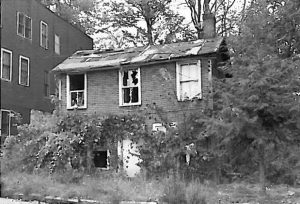
45 South Federal Street, Pre Urban Renewal
The Saratoga Springs Urban Renewal Program was arguably one of the most ambitious and controversial projects undertaken during the 102 year history of the City of Saratoga Springs. Lasting from 1962 through 1986, it was the largest urban change of the City’s history. There were three Urban Renewal projects in Saratoga Springs, one on the west side of Broadway, another in the Spring Valley or “Gut” area, and a third project near Putnam and Henry Streets.
“The City Council took its first step the other night in handling one of the most difficult of civic problems – removal of deteriorated buildings which contribute to urban blight. It began steps to remove five buildings.” This quote from The Saratogian shortly after the Urban Renewal project was approved shows how the community at-large felt about the condition of our housing and buildings in general. World War II had ended, gambling had been made illegal in the city, many of the grand old hotels had been torn down, and much of the housing stock was in poor condition. Threats from suburban developments on the outskirts of the city and nearby surrounding communities had hurt the downtown business district. Many felt that the city was suffering from blighted buildings and there was a need to “update” our city with new development.
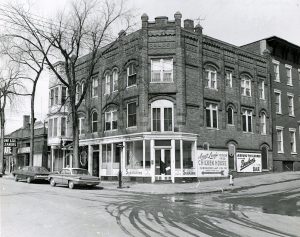
Northwest corner of Division and Woodlawn, 1969
So what was Urban Renewal? Federally, it was Title I of the Federal Housing Act of 1949. The Act provided federal funding for cities to cover costs of acquiring areas that were considered to be “slum” areas. The idea was to tear down dilapidated buildings within a project, consolidate the lots, and then sell those lots to developers to create new “modern” residential and commercial buildings. In Saratoga Springs, the Urban Renewal Program was approved in 1961 and the Urban Renewal Agency (URA) was formed in 1962. The Agency had six stated goals: eliminate slums and blight; expand and strengthen the central business district; establish a central residential area; expand the tax base; provide off-Street parking; and improve infrastructure and traffic patterns.
The process for executing the Urban Renewal Program was cumbersome. The City of Saratoga Springs condemned large areas for the project areas. The URA then notified residents that their homes or businesses would be taken and they would be relocated. Next the structures were demolished, resulting in vacant parcels to be sold to developers for new projects. In the interim, new utilities were installed and the streets were upgraded with new sidewalks and curbs.
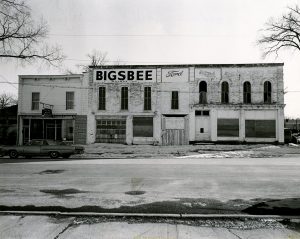
16-22 Congress Street
As the projects progressed, there was concern among the residents in the project areas that the program was not serving their needs. Many of those displaced by the URA were not satisfied with the money they received for their property and the small amount given for moving expenses. There were advisory committees made up of residents that were little used and had limited effectiveness in moving the URA toward being more responsive to the public. For example, with the project on the west side of Broadway, none of the buildings slated for demolition were rehabilitated or preserved. As the Urban Renewal program progressed, the committee established for the Spring Valley project was more effective in this regard.
As Urban Renewal continued, more citizens became concerned that the city was losing its historic character and efforts began to reverse this trend to whatever extent possible. In the Spring Valley project, several properties were rehabilitated and some were preserved. The Mouzon House on York Street, the Carroll Auto Sales building (which remained until the Hampton Inn and 38 High Rock condominiums were built), and 18 Lake Avenue were rehabilitated and preserved. The Great Bay Clam Company, located at the corner of Broadway and Grove Street (now Ellsworth Jones Place) was moved to Spring Street, where it is now the Bread Basket Bakery. Only through the advocacy of the Foundation, which listed the former rare example of the Pure Oil gas station on the National Register of Historic Places, did this happen. The URA itself was not truly in the business of preserving or rehabilitating buildings on a large scale.
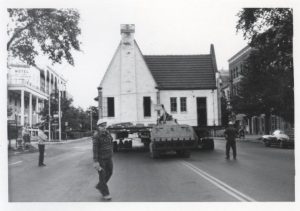
Moving of the Pure Oil Gas Station, Now located on Spring Street.
Today, a program like Urban Renewal would likely not be considered by the City of Saratoga Springs. First, the Federal funding programs that the Urban Renewal Program benefitted from no longer exist. Second, the liberal use of eminent domain and condemnation processes are not looked upon favorably by citizens, possibly as a result of the Urban Renewal Program. Lastly, Saratoga Springs has made a firm commitment to preservation, rather than demolition and redevelopment, as the way to keep the city vibrant and is how we achieve the stated goals of the URA today.
The City Center Parking Garage, for example, was originally proposed in the early 1980s, but was put off for lack of funding. Some Urban Renewal sites have been redeveloped, such as the pedestrian mall on Broadway across from Caroline Street which today is Putnam Market. In hindsight, many feel the program ruined the very fabric of the community, including the large African-American community that was essentially displaced from the west side of Broadway. However, in terms of infrastructure, the program literally cleared the way for large development projects, such as the City Center and the Public Library which have provided tremendous benefit to the community. It established the parking areas on Woodlawn Avenue and High Rock Avenue. It also resulted in affordable housing projects such as Gaslight Apartments, Spring Valley Apartments, and Congress Place, along with low-income housing at the Stonequist Apartments. As time moves on and our city evolves, we as a community will continue to evaluate the effects of the Urban Renewal Program and how it affected our community.
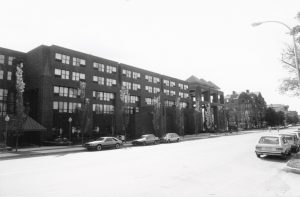
Saratoga Springs City Center and Hotel, 1985
Matthew Veitch is the Saratoga Springs County Supervisor and Treasurer of the Saratoga Springs Preservation Foundation. Founded in 1977, the Saratoga Springs Preservation Foundation is a private, not-for-profit organization that promotes preservation and enhancement of the architectural, cultural and landscaped heritage of Saratoga Springs. To learn more or to become a member, please visit www.saratogapreservation.org.
